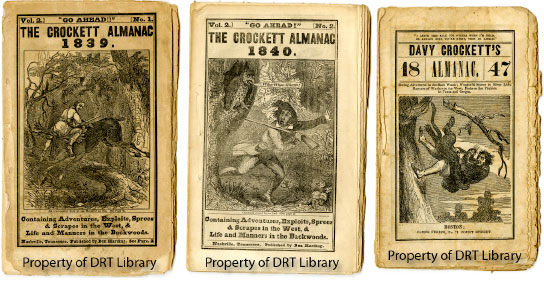From the DRT Library: Davy Crockett Almanacs
From 1835 – the year that David Crockett lost his Congressional seat and headed to Texas – to 1856, at least 45 versions of The Crockett Almanac/Davy Crockett’s Almanac were published by various firms. The DRT Library is in possession of three copies from 1839, 1840, and 1847. Historian Paul Andrew Hutton has explored the significance of the almanacs, writing:
A celebrity in his own time, Crockett was elevated to near-mythical status by his heroic death at the Alamo in 1836…He had courted fame while alive, and…he had taken an active role in the creation of his own overblown legend. His story, however, quickly became the property of others. They greatly embellished the core of truth he had projected to create the archetypical backwoodsman and Jacksonian self-made man who captured the imagination of the world.
Additionally, asserts Hutton,
The almanacs ensured a continued notoriety for Crockett long after his death, while at the same time creating a Herculean Davy who accomplished deeds far beyond the capacity of any ordinary mortal. They invented a hard-edged hero for the masses, the popular audience that at first parodied but soon eclipsed Cooper’s romanticized Leatherstocking as the frontier ideal. They enshrined the democratic humor of an expansive, rough-hewn, and bawdy people replete with local idioms, bizarre dialects, fantastic characters, cruel racism, eccentric wit, and clever tricks. The almanac Davy was part braggart, part trickster, part fantasy hero, and all American. He mirrored a still evolving national character – celebrating its crudeness, its toughness, its daring, its egalitarianism, and, above all, its wit.
The Crockett almanacs contained some of the same information found in other nineteenth-century almanacs, including calendars, sunrise and sunset times, astronomical data, and important dates, historical anniversaries, and holidays. Primarily, however, the almanacs focused on Crockett himself. Throughout their entire publication history, the almanacs featured comic and exaggerated stories about Crockett battling, hunting, or escaping from eccentric characters (both men and women) and wild animals. Interwoven with these accounts were “folk wisdom and backwoods humor.”
Hutton argues that publication of the Crockett almanacs ceased in the middle 1850s because “the nation was fast losing its sense of humor,” and “rustic tall tales from a seemingly distant past gave little solace to readers facing a dark future.” Additionally, asserts Hutton, “the nationalism of the almanacs soon found fewer adherents in the South, while Crockett looked a bit too Southern to many in the North.” Even though the almanacs eventually fell out of favor with American readers, they had been enormously popular for more than twenty years.
